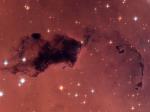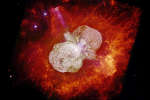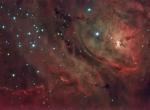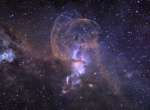
|
You entered: dark nebula
 A Dust Cloud in NGC 281
A Dust Cloud in NGC 281
20.04.2006
Stars themselves can create huge and intricate dust sculptures from the dense and dark molecular clouds from which they are born. The tools the stars use to carve their detailed works are high energy light and fast stellar winds.
 The Turbulent Neighborhood of Eta Carina
The Turbulent Neighborhood of Eta Carina
25.11.2003
How do violent stars affect their surroundings? To help find out, astronomers pointed the Hubble Space Telescope to the regions surrounding Eta Carina, a star showing signs that it may explode sometime in the next million years.
 APOD: 2008 June 17- Eta Carinae and the Homunculus Nebula
APOD: 2008 June 17- Eta Carinae and the Homunculus Nebula
17.06.2008
How did the star Eta Carinae create this unusual nebula? No one knows for sure. About 165 years ago, the southern star Eta Carinae mysteriously became the second brightest star in the night sky. In 20 years, after ejecting more mass than our Sun, Eta Car unexpected faded.
 The Starry Sky under Hollow Hill
The Starry Sky under Hollow Hill
30.08.2014
Look up in New Zealand's Hollow Hill Cave and you might think you see a familiar starry sky. And that's exactly what Arachnocampa luminosa are counting on. Captured in this long exposure...
 M8: The Lagoon Nebula
M8: The Lagoon Nebula
9.02.2006
This beautiful cosmic cloud is a popular stop on telescopic tours of the constellation Sagittarius. Eighteenth century cosmic tourist Charles Messier cataloged the bright nebula as M8, while modern day astronomers recognize the Lagoon...
 NGC 6188 and NGC 6164
NGC 6188 and NGC 6164
28.07.2011
Fantastic shapes lurk in clouds of glowing hydrogen gas in NGC 6188. The emission nebula is found near the edge of a large molecular cloud, unseen at visible wavelengths, in the southern constellation Ara, about 4,000 light-years away.
 The NGC 3576 Nebula
The NGC 3576 Nebula
25.03.2008
An intriguing and beautiful nebula, NGC 3576 drifts through the Sagittarius arm of our spiral Milky Way Galaxy. Within the region, episodes of star formation are thought to contribute to the complex and suggestive shapes. Powerful winds from the nebula's embedded, young, massive stars shape the looping filaments.
 NGC 6188 and NGC 6164
NGC 6188 and NGC 6164
29.03.2016
Fantastic shapes lurk in clouds of glowing gas in the giant star forming region NGC 6188. The emission nebula is found about 4,000 light years away near the edge of a large molecular cloud unseen at visible wavelengths, in the southern constellation Ara.
 Stardust in Aries
Stardust in Aries
24.11.2010
This composition in stardust covers almost 2 degrees on the sky, close to the border of the zodiacal constellation Aries and the plane of our Milky Way Galaxy. At the lower right...
 APOD: 2023 July 18 Б Milky Way above La Palma Observatory
APOD: 2023 July 18 Б Milky Way above La Palma Observatory
17.07.2023
What's happening in the night sky? To help find out, telescopes all over the globe will be pointing into deep space. Investigations will include trying to understand the early universe, finding and tracking Earth-menacing asteroids, searching for planets that might contain extra-terrestrial life, and monitoring stars to help better understand our Sun.
|
January February March April |
|||||||||||||||||||||||||||||||||||||||||||||||||